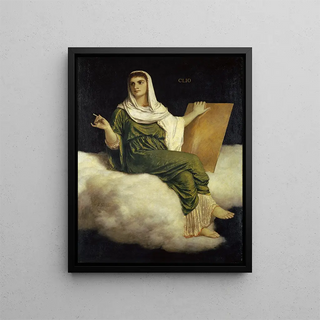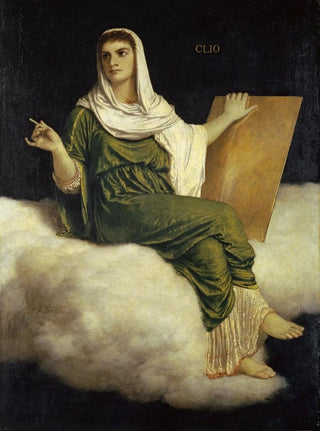Art print | Clio the Muse - Arnold Böcklin


View from behind

Frame (optional)
Art print La Muse Clio - Arnold Böcklin – Captivating Introduction
In the vibrant universe of art, some works stand out for their ability to capture the very essence of inspiration and creativity. "La Muse Clio" by Arnold Böcklin is one of those iconic pieces that transcend the simple frame of painting to evoke a world where mythology and imagination blend harmoniously. Through this piece, the viewer is invited to immerse themselves in a universe where time seems suspended, where each brushstroke tells a story. Clio, the muse of history, is depicted with a grace and majesty that intrigue and fascinate, offering a gateway to reflection on our own relationship with art and memory.
Style and uniqueness of the work
Arnold Böcklin's style is characterized by a symbolist and romantic approach, where nature and humanity intertwine in a poetic dance. "La Muse Clio" stands out with its shimmering colors and fluid shapes, which seem to vibrate under the effect of a golden light. The composition, both balanced and dynamic, highlights the central figure of Clio, whose serene and contemplative expression evokes timeless wisdom. The natural elements surrounding her, such as flowers and foliage, add an organic dimension to the piece, reinforcing the idea that artistic inspiration is intrinsically linked to the beauty of the world around us. Böcklin manages to create an atmosphere that is both dreamlike and tangible, where every detail contributes to the overall harmony of the scene.
The artist and his influence
Arnold Böcklin, Swiss painter of the 19th century, is often regarded as one of the pioneers of symbolism. His unique artistic vision, influenced by romanticism and neo-classicism, marked his era and continues to inspire many contemporary artists. Through his works, Böcklin explores themes such as mythology, death, and nature, inviting the viewer to deep introspection. "La Muse Clio" fits into this quest for meaning, where art becomes a means of questioning our collective history and our place in the

Matte finish

View from behind

Frame (optional)
Art print La Muse Clio - Arnold Böcklin – Captivating Introduction
In the vibrant universe of art, some works stand out for their ability to capture the very essence of inspiration and creativity. "La Muse Clio" by Arnold Böcklin is one of those iconic pieces that transcend the simple frame of painting to evoke a world where mythology and imagination blend harmoniously. Through this piece, the viewer is invited to immerse themselves in a universe where time seems suspended, where each brushstroke tells a story. Clio, the muse of history, is depicted with a grace and majesty that intrigue and fascinate, offering a gateway to reflection on our own relationship with art and memory.
Style and uniqueness of the work
Arnold Böcklin's style is characterized by a symbolist and romantic approach, where nature and humanity intertwine in a poetic dance. "La Muse Clio" stands out with its shimmering colors and fluid shapes, which seem to vibrate under the effect of a golden light. The composition, both balanced and dynamic, highlights the central figure of Clio, whose serene and contemplative expression evokes timeless wisdom. The natural elements surrounding her, such as flowers and foliage, add an organic dimension to the piece, reinforcing the idea that artistic inspiration is intrinsically linked to the beauty of the world around us. Böcklin manages to create an atmosphere that is both dreamlike and tangible, where every detail contributes to the overall harmony of the scene.
The artist and his influence
Arnold Böcklin, Swiss painter of the 19th century, is often regarded as one of the pioneers of symbolism. His unique artistic vision, influenced by romanticism and neo-classicism, marked his era and continues to inspire many contemporary artists. Through his works, Böcklin explores themes such as mythology, death, and nature, inviting the viewer to deep introspection. "La Muse Clio" fits into this quest for meaning, where art becomes a means of questioning our collective history and our place in the






